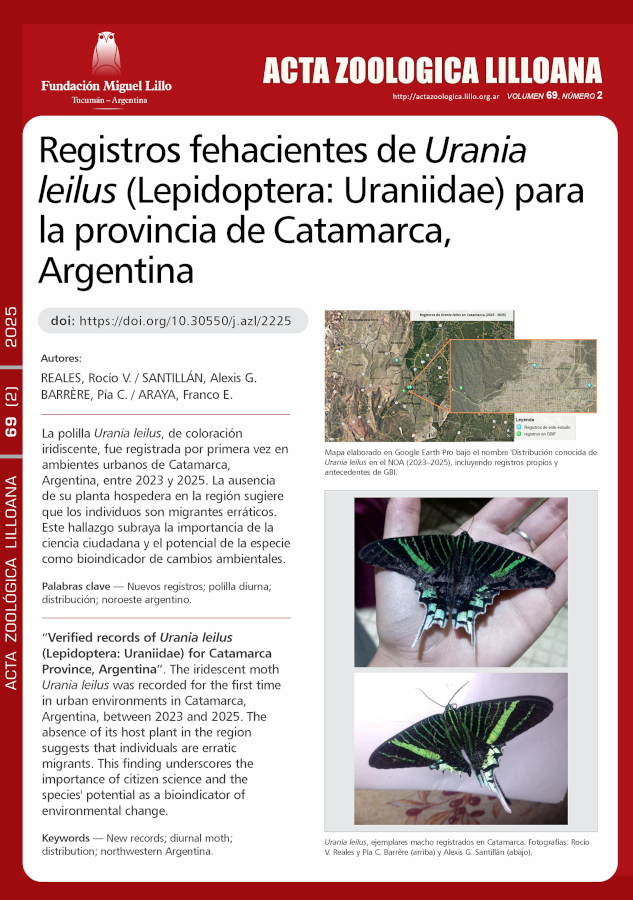Verified records of Urania leilus (Lepidoptera: Uraniidae) for Catamarca Province, Argentina
DOI:
Keywords:
New records, diurnal moth, distribution, northwestern ArgentinaAbstract
Urania leilus (Lepidoptera: Uraniidae) is a diurnal moth distinguished
by its velvet black coloration and iridescent green bands. Its primary
distribution includes the Amazon Basin and other tropical areas, but
recent reports document occurrences in Argentina, including new re-
cords from Catamarca Province. The study presents the first confirmed
observations of U. leilus in urban and peri-urban environments in cen-
tral and western Catamarca —specifically in San Fernando del Valle de
Catamarca and Andalgalá— between 2023 and 2025. All individuals
were photographed, georeferenced, and observed under varied envi-
ronmental conditions, perched on plant species unrelated to the genus
Omphalea, the only known larval host. The absence of Omphalea in
the region suggests that these individuals are accidental migrants or
erratic dispersers, with no evidence of established populations. Potential
causes include unintentional transport, wind dispersal, or environmental
changes. The study also integrates citizen science records and describes
the arid phytogeographic context of the sampled sites. These findings
highlight the importance of collaboration between formal science and
local observers in improving faunal inventories. Additionally, U. leilus
is proposed as a potential bioindicator species, due to its speacialized
diet and migratory behavior. Finally, the lack of conservation status for
this species in the IUCN and national agencies underscores the urgent
need for more systematic research, especially in underexplored regions
such as northwestern Argentina.
Downloads
References
Andrada, M. A., & Inga Quarin, L. M. (2024). Nuevo registro documentado de corbatita overo (Sporophila lineola) en Catamarca, Argentina. Nuestras Aves, 69, 123–124.
Aragón Martínez, A. B. (2021). Diversidad de mariposas diurnas (Insecta: Lepidoptera) en la localidad de Huaycama, departamento Ambato, provincia de Catamarca (Tesis no publicada de licenciatura). Facultad de Ciencias Exactas y Naturales, Universidad Nacional de Catamarca.
Barrios-Montivero, A. E., Salas, L. B., & Ojanguren-Affilastro, A. A. (2024). Descripción de Timogenes pipanaco sp. nov. (Scorpiones, Bothriuridae), una nueva especie de salar del noroeste de Argentina. Zootaxa, 5536(2), 277–290. https://doi.org/10.11646/zootaxa.5536.2.4
Brown Jr., K. S., & Freire, A. V. L. (2007). Lepidoptera as indicators of environmental quality in Brazil. I. The role of insects in environmental quality assessment. Embrapa Meio Ambiente.
De Bustos, S., & Alderete, E. (2020). Primeros registros de pecarí de collar Pecari tajacu (Mammalia: Artiodactyla) para Monte de Sierras y Bolsones y en la provincia de Catamarca, República Argentina. Notas sobre Mamíferos Sudamericanos, 2, e19.0.17. https://doi.org/10.31687/saremNMS.19.0.17
Goulson, D. (2013). An overview of the environmental impacts of pesticides. Science, 340(6134), 1215–1219.
Katinas, L., Guerrero, E. L., & Dosil Hiriart, F. D. (2022). La fitogeografía argentina según Joaquín Frenguelli y Ángel Lulio Cabrera y el predominio de una perspectiva biogeográfica histórica. Revista del Museo de La Plata, 7(2), 81–94. https://doi.org/10.24215/25456377e159
Lees, D. C., & Smith, N. G. (1991). Foodplant associations of the Uraniinae (Uraniidae) and their systematic, evolutionary, and ecological significance. Journal of the Lepidopterists’ Society, 45(4), 296–347.
Lees, D. C., & Smith, N. G. (1991). Foodplant relationships of the neotropical day-flying moth Urania fulgens (Uraniidae). Journal of the Lepidopterists’ Society, 45(1), 1–13.
Martínez, G. (2021). Primeros registros de ocelote Leopardus pardalis (Linnaeus, 1758) (Carnivora: Felidae) en la provincia de Catamarca, Argentina. Acta Zoológica Lilloana, 65, 1–9. https://doi.org/10.30550/j.azl/2021.65.1/2021-02-11
Merritt, T. J. S., Biesboer, D. D., & Briske, D. D. (2013). Conservation of butterflies and moths. Cambridge University Press.
Morlans, M. C. (1995). Regiones naturales de Catamarca: Provincias geológicas y provincias fitogeográficas (2ª ed.). Editorial Científica Universitaria, Universidad Nacional de Catamarca.
Nuñez-Penichet, C., Maita, J., & Soberon, J. (2024). Land-cover change in Cuba and implications for the area of distribution of a specialist’s host-plant. PeerJ, 12, e17563. https://doi.org/10.7717/peerj.17563
Parmesan, C. (2006). Ecological and evolutionary responses to recent climate change. Annual Review of Ecology, Evolution, and Systematics, 37, 637–669.
Penco, F. C. (2013). Lepidoptera Argentina. Parte IV: Sematuridae & Uraniidae. Edición del autor. ISBN 978-987-33-1739-2.
Ríos, S. D., & Smith, P. (2015). Sobre la ocurrencia de Urania leilus Linnaeus (Lepidoptera: Uraniidae: Uraniinae) en el Paraguay. Paraquaria Natural, 3(2), 19–21. https://www.researchgate.net/publication/288838794
Smith, N. G. (1972). Migrations of the day-flying moth Urania in Central and South America. Caribbean Journal of Science, 12(2), 45–58.
Smith, N. G. (1992). Reproductive cycles of Urania fulgens and Urania leilus (Lepidoptera: Uraniidae) and their host plants (Omphalea spp., Euphorbiaceae). Journal of the Lepidopterists’ Society, 46(2), 105–115.
Vinciguerra, R. (2009). Osservazioni su Urania sloanus (Cramer, 1779) (Lepidoptera: Uraniidae). SHILAP Revista de Lepidopterología, 37, 307–312.
Downloads
Published
How to Cite
Issue
Section
License
Copyright (c) 2025 Acta Zoológica Lilloana

This work is licensed under a Creative Commons Attribution-NonCommercial-NoDerivatives 4.0 International License.









